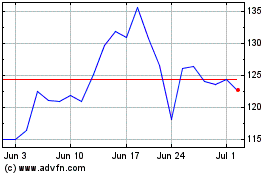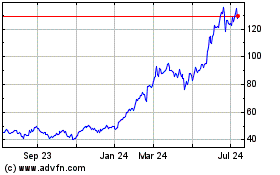By Yoko Kubota and Dan Strumpf
Huawei Technologies Co. has spent 15 years and billions of
dollars building an advanced semiconductor company, with the aim of
making the Chinese telecom giant self-sufficient. A U.S.
blacklisting stands to set it back years in that goal.
Huawei's chip subsidiary HiSilicon Technologies Co. has grown
into one of China's biggest and most advanced chip companies. Its
processors power everything from Huawei's data centers and
smartphones to its base stations for forthcoming fifth-generation
wireless networks.
HiSilicon supplies more chips than anyone else for Huawei,
reducing its parent company's reliance on American chip stalwarts
like Qualcomm Inc., Intel Corp. and Nvidia Corp., and helping erode
the dominance of American chip makers. But HiSilicon is among
dozens of Huawei affiliates on a U.S. Department of Commerce export
blacklist that blocks any company from supplying it with American
technology without a license, which won't be easy to obtain.
Because HiSilicon relies on some suppliers for American software
and intellectual property to design and make semiconductors, its
ability to keep producing better chips is at risk. While experts
say the short-term effects of the export ban will be minimal, in
the longer run, as technology evolves, it threatens to curtail
HiSilicon's progress.
"Beyond a year from now, there is a big risk if the ban is not
lifted," said Sebastian Hou, analyst at the Hong Kong-based
investment bank CLSA. "It would be very challenging for HiSilicon
to design next-generation chipsets because a lot of software and
intellectual property is still licensed and bought from American
suppliers."
A Huawei spokesman declined to comment for this article.
Semiconductors have emerged as a choke point in the U.S.-China
tech battle. China needs American semiconductor technologies, while
U.S. chip makers rely on Chinese buyers. The threat to HiSilicon
shows China's tech industry has a way to go to establish a
self-sufficient supply chain.
With the U.S. blacklisting, HiSilicon stands to lose access to
technology from ARM Holdings PLC, the U.K.-based provider of basic
chip designs. It also will prevent HiSilicon from using the latest
software from U.S. suppliers Synopsys Inc. and Cadence Design
Systems Inc., making it harder to produce next-generation
chips.
On Friday, China's Commerce Ministry said it is setting up an
"unreliable entity list," and that foreign companies, organizations
and individuals that disrupt supplies to Chinese companies would be
named.
HiSilicon President Teresa He told Huawei employees in a May 17
memo that all new products must have plans for technological
self-sufficiency. "We must not only be open to innovation but also
achieve independence in technologies," Ms. He said.
China's reliance on U.S. chips was highlighted after last year's
U.S. ban on exports to Huawei's chief Chinese rival, ZTE Corp.,
crippled the company. ZTE was able to get back to business after
the U.S. and China reached a deal that included the company paying
a $1 billion fine.
Experts say Huawei is less reliant on American technology than
ZTE, in part because of HiSilicon. In 2015, HiSilicon supplied more
than one-fifth of Huawei's chips by value, according to CCID, an
official think tank in Beijing. Analysts estimate the figure has
only grown since then.
In Huawei's high-end P20 Pro smartphone launched last year,
about 27% of the semiconductor content came from HiSilicon, while
only 7% came from American companies, according to ABI Research. In
the case of ZTE, more than half of the electronic components in its
top-of-the-line smartphone ran on American components when its ban
hit.
Established in 2004, Shenzhen-based HiSilicon has more than
7,000 employees globally. Its revenue rose 38% in 2018 to $7.9
billion, according to market research firm TrendForce. About 90% of
HiSilicon's revenue comes from Huawei, research firm Gartner said.
Huawei reported more than $100 billion in revenue last year.
HiSilicon is among an elite group of global chip makers that
have succeeded in engineering transistors down to seven nanometers
in size, the industry's current gold standard.
In smartphones, HiSilicon's Kirin-branded chips power
image-recognition and other artificial intelligence functions. In
the future, its Balong chips will connect those phones and other
devices to forthcoming 5G networks, while its Tiangang chips will
power Huawei's 5G base stations.
The looming trouble for HiSilicon is in obtaining new licenses
to access design tools offered by Synopsys and Cadence, both based
in California. The companies' products are used to produce the
blueprints for circuits, and U.S. officials have said applications
for licenses to export these products to Huawei and its affiliates
will be reviewed with a presumption of denial.
In a conference call with investors , Synopsys co-CEO Aart de
Geus said the company was following "exactly the rules set by the
government," including no longer providing on-site support to
HiSilicon. Cadence didn't respond to requests for comment.
The loss of ARM's business likely won't be felt immediately.
Huawei's CEO Ren Zhengfei said in May it has obtained a long-term
license and that the ARM halt "doesn't have an impact." An ARM
spokeswoman said the company is speaking with the U.S. government
to ensure compliance, while a spokesman for ARM China, a separate
entity, said the company is seeking solutions that comply with the
law.
While other chip makers and HiSilicon's suppliers shift to
future versions of ARM technology or products from the software
companies, the U.S. blacklisting will leave HiSilicon stuck with
older tools, hindering its ability to compete on the frontiers of
chip design and extending the time it takes to develop its
products.
In terms of developing new advanced chips, "I foresee 36 months
of midterm setback for Huawei," said Shumpei Kawasaki, CEO of
Software Hardware & Consulting and a former chip designer at
Hitachi Ltd. and Renesas Electronics Corp.
Alternative technologies to ARM, Cadence and Synopsys exist,
including open-sourced RISC-V that was originally developed at the
University of California, Berkeley. Some of RISC-V's design data is
accessible in open platforms and doesn't require signing an
agreement to use that, Mr. Kawasaki said.
In the long run, an export ban would push China toward a
separate set of chip-design tools and standards and lead HiSilicon
to step away from internationally dominant chip architecture and
tools, Mr. Kawasaki said.
--Wenxin Fan contributed to this article.
Write to Yoko Kubota at yoko.kubota@wsj.com and Dan Strumpf at
daniel.strumpf@wsj.com
(END) Dow Jones Newswires
June 02, 2019 05:45 ET (09:45 GMT)
Copyright (c) 2019 Dow Jones & Company, Inc.
NVIDIA (NASDAQ:NVDA)
Historical Stock Chart
From Mar 2024 to Apr 2024

NVIDIA (NASDAQ:NVDA)
Historical Stock Chart
From Apr 2023 to Apr 2024
